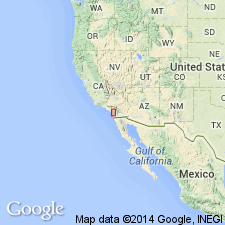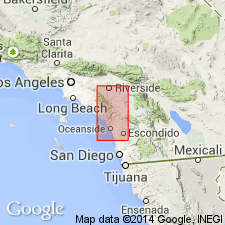
- Usage in publication:
-
- Escondido Creek leucogranodiorite*
- Modifications:
-
- Original reference
- AAPG geologic province:
-
- Capistrano basin
Summary:
Pg. 489. Escondido Creek leucogranodiorite. Named in this report on study of batholith in southern California. Age is Cretaceous.
Source: US geologic names lexicon (USGS Bull. 1200, p. 1281).

- Usage in publication:
-
- Escondido Creek leucogranodiorite*
- Modifications:
-
- Overview
- Dominant lithology:
-
- Leucogranodiorite
- Leucotonalite
- AAPG geologic province:
-
- Capistrano basin
Summary:
Pg. 87-89, pl. 1. Fine-grained, light-colored rock that ranges in composition from leucogranodiorite to leucotonalite and averages granodiorite. Along most of its contact, it intrudes Santiago Peak volcanics but in some places intrudes both Green Valley tonalite and San Marcos gabbro. Derivation of name given. Age is Cretaceous.
Named from its excellent and characteristic development in canyon of Escondido Creek, San Diego Co., southern CA. Largest exposed mass of this rock occupies area about 7 sq mi mostly in drainage of Escondido Creek.
Source: US geologic names lexicon (USGS Bull. 1200, p. 1281).
For more information, please contact Nancy Stamm, Geologic Names Committee Secretary.
Asterisk (*) indicates published by U.S. Geological Survey authors.
"No current usage" (†) implies that a name has been abandoned or has fallen into disuse. Former usage and, if known, replacement name given in parentheses ( ).
Slash (/) indicates name conflicts with nomenclatural guidelines (CSN, 1933; ACSN, 1961, 1970; NACSN, 1983, 2005, 2021). May be explained within brackets ([ ]).

